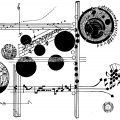entomusica is an ongoing artistic research project about making music from, with and for insects
more than just making human music from of insect sounds, the main goal is to speculate on an understanding of insect music. this experiment shows, for example, the orchestral piece “Flight of the bumblebee”, by Rimsky-Korsakov, speeded up 64 times until is sounds like a chirp. insect hearing and sound production occurs generally in a much higher frequency range than that of human music and hearing, so how would an insect listen to this “transposed” version of Rimsky-Korsakov’s music?
a first description (in portuguese only, but i am working on an english version of it) of entomusica’s process, followed by some reflections, as a result of a lecture/conversation at MediaLabMX, Mexico City, in 2018.
The entomúsica project arises from the idea of creating a sound installation in an urban bush, which occurred to me as one of the possibilities in the various that arise when we investigate and even just think about those quasi-sites. Understanding the bushes as living places, wild islands in the concrete city, I started to consider the beings that inhabit them. I started thinking about humans: outcasts, drug addicts, drifters, criminals… who visits the wild bushes of the metropolis? Who picnics on the bushes or does campsites in vacant lots?
From humans, we move easily to the fauna that inhabits these scar of flora on the concrete skin. Immediately, I recalled a biologist friend having mentioned the impact of the trios elétricos on the sea animals around the Barra lighthouse at Carnival time. Then I thought of doing something that would be less disturbing to insects, frogs, rats, etc. than to humans. Many of these animals have sound perception and emission patterns that generally operate in high- and super-high pitch ranges, far beyond ultrasound (bats, as far as I understand, are the “soprano” of this tessitura, some going beyond 250kHz).
I decided, out of a particular fondness, to start studying insects hearing. This came with the idea of creating a kind of music that, at the same time, would be audible to insects (and inaudible to humans) and that would make audible to humans the sounds produced by insects, through filtered frequency capture translated into other sounds or lower octaved versions of the insects’ own sounds and songs – a common resource in the field of biology to make audible the ultrasounds produced by animals.
I then thought of a system to be installed in the bushes, in order to capture the sounds of insects and to reproduce them to humans and also to produce music that insects could listen. The ideal time for the system to be put into operation is at night. Some technical issues arised in the daydreaming phase: Would a command based on a noise sensor be able to keep the system running for a few days without interference? Would it be possible to switch on automatically when the noise threshold drops to the basic night-time standard levels on site?
Would it be possible, the system would start to generate audible sounds to passers-by (and insects?) as the street becomes quieter. It would be important to ensure a smooth amplification of sounds. The fact that the frequencies are quite high (to the range of human hearing) can ensure that they are perceived by humans prominently, in the most mid-bass soundscape of many urban night environments.
As an incipient idea, I thought of some ways to realize it even without so much detail and logistics.
Basic Form = no automated feedback, no sensors:
To create small sound automata from the parameters of the insect songs, collected and processed. To install them in the bush and program them to shoot, or to trigger them with a big delay until the starting of the sounds, to ensure that the bush is deserted at the moment of the music.
MORE BASIC FORM = no system:
Installation of collected and processed pieces. Doing the collection of sounds and ultrasounds, translating them into audible pieces, installing them in micro-devices into the bushes. The same long silence scheme before reproduction can ensure the “invisibility” of the performance, especially if there is the possibility of playing files that last for many hours.
